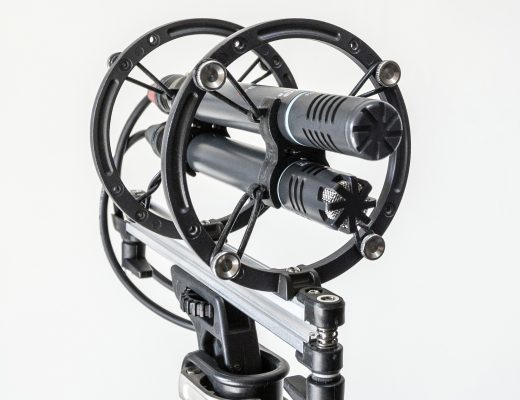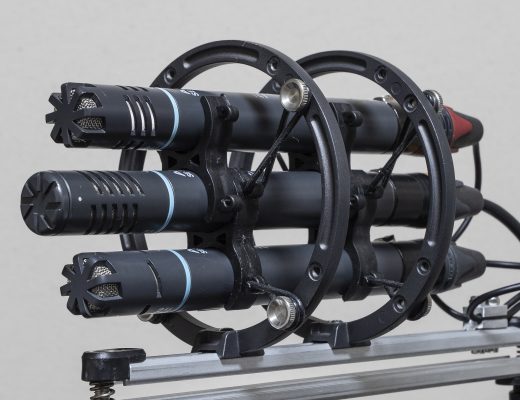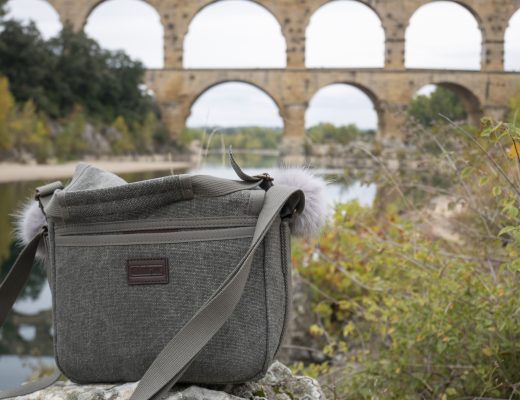
Introduction
In part 1 of this three-part blog-post series, I described the challenge of getting an ORTF pair into the new and diminutive (80mm diameter) Mini-ALTO from Radius Windshields and in part 2 I covered testing. In both cases I used the Sennheier MKH 8040 with an adapted (side-entry) MZL connector as this is one of the shortest cardioid mics available and, of course, due to its RF design, is particularly well suited to – and is a popular choice for – recording outdoors. That I had a pair also helped! While the MKH 8040 is an excellent choice, obviously it would make the chances of Radius Windshields turning this proof of concept into an actual product all the more likely if other mics could be used too, and that is subject of this post.

The MKH 8040 with its shortened MZL has a total length of 54mm although the key measurement is the 47mm length of the 19mm diameter part of the mic (the heavily tapered 7mm part of the modified connector beyond that has no implications when angled for ORTF, as you can see from the overhead photo above). This enables the centre of the diaphragms of the ORTF mic pair (angled, of course, at 110 degrees and spaced 170mm apart) to be on the centre-line of the windshield: that is, 40mm from the basket in all directions. There is little point jamming mics into a windshield if they end up right near the basket since this simply hampers the effectiveness of the wind-noise reduction, so that central location remained a requirement as I looked at other candidates. A maximum length of around 47mm – and without any problematic projections of connectors or rear cables beyond that – rules out mics with XLR connectors (and I have excluded cardioid lav mics on the basis of high self-noise), but there are a few viable options that I have identified and have tested: these are all modular mics from makers of microphones aimed at (though by no means exclusive to!) professional recordists (i.e. not cheap) – Schoeps, DPA and Nevaton.
Few of the less expensive small mics have modular designs with small preamps and no XLR connector. For example, the seemingly short Rycote CA-08 is 78mm long and you need to allow for a low-profile XLR too – another 25mm – bringing it to over 100mm and over twice the length that would work effectively for ORTF in a Mini-ALTO. Even mics assembled, like many a DIY mic, with Primo capsules – such as the small Line Audio CM4 (77mm long + 25mm low-profile XLR) or the Sonorous Objects SO.103 (52mm + 25mm low-profile XLR) and SO.3 (83mm) – are too long, although, of course, such mics are reminders that for the practically minded it would be easy enough to use the same capsules (e.g. the Primo EM200, which is what I believe is used in the Line Audio CM4) to make a suitably short mic without an XLR connector. And, equally, there may well be budget-friendly mics from manufacturers that would suit ORTF in a Mini-ALTO that I have missed: I hope so!

Schoeps – CMC 1 KV and MK4
Compared to the Sennheiser MKH 8000 series, the offerings from Schoeps are varied and complex and it took me a fair bit of time – and a few blind alleys – to identify exactly which model (and there is only one) would fit the criteria for ORTF in a Mini-ALTO. Schoeps aficionados will doubtless snigger mercilessly at this unfamiliarity, but, anyway, eventually I happened across the CMC 1 KV, which was introduced in 2022. It is a short preamp (the shortest version of the CMC 1) with a side-entry cable, which, when combined with a MK 4 cardioid capsule, gives an overall mic length of 45mm. With a steel element in its rear it can be used with magnetic mounts (several were supplied in the case) and is very much designed as a plant mic (for example, useful for recording dialogue in cars, where mic placement is always tricky) or for any other purpose where such a short length is required. Of course, it would have been nice if one of the more popular Schoeps preamps would have fitted the Mini-ALTO for ORTF, but at least the CMC 1 KV takes any of the popular MK capsules. And while only some may have the preamp in their kit already, others may find it a handy addition for a compact ORTF rig and for plant mic use and worth purchasing (it’s similarly priced to the other CMC 1 amplifiers).
Having identified the best Schoeps mic to fit the Mini-ALTO for ORTF, the good folks in Durlach (in Karlsruhe) sent me a pair to test: sadly this is just a loan and not to keep!

Right, that’s enough looking at the fancy Schoeps wooden case and contents: onto the ORTF rig itself. Adapting the proof of concept set up for the MKH 8040 to the CMC 1 KV + MK 4 was very straightforward: given the similar mic length, all that needed changing was to make some 20mm mic clips (the MKH 8000 mics being Ø19mm) and, as a consequence, very slightly tweak the joining part of the bar. The side-exit cables are a little beefier and less flexible than the custom dual MZL cables from ETK Cables for the MKH 8040, but that’s understandable because – at 3m long – they aren’t intended to be used purely inside a windshield: so careful clipping of the cable becomes essential to reduce cable-borne noise.


DPA – 4011 with MMP-GS or MMP-ES preamp
Back in 2013 DPA launched the MMP-ES, which is a small preamp measuring only 12mm long and with a side-exit cable. This was followed in 2016 by the similarly-sized MMP-GS, with the only difference being that the latter has a micro-dot connection rather than an XLR: rather neatly, and admittedly beside the point for this exercise, this allows many DPA SDCs to be powered from 5V and, therefore, used with wireless transmitters. Combined with a DPA 4011 cardioid capsule, the MMP-GS (or the MMP-ES) gives an overall length of 33mm which is remarkable, and significantly shorter than the other options considered here. Initially I did wonder whether such a short length meant I could tease it away from the centre-line of the windshield to increase wind performance, but modelling the capsule position with the cardioid polar pattern showed that this would be disadvantageous: the wide 110-degree angling of ORTF does mean that the centre of the windshield is best. So keeping the capsule position centrally meant making a new ORTF bar, which was easy enough with 3d-printing, but set me thinking: if Radius do take this forward, an adaptable bar for at least several different mic models seems ideal. One for their skilled designer, Tim, I think! Back to the DPA pair: in short, they fit (of course) and more easily than the other mics. Although the 4011 cardioid capsule is quite popular, the MMP-ES and MMP-GS are less common, but, as with the Schoeps, they do have their uses for small plant mics etc.: worst case, existing 4011 cardioid owners seeking super-compact ORTF could buy the short preamps and, at least, they are not crazily expensive (about £350 + VAT). For some users the 18 dB(A) self-noise might be a little high – it is certainly above the 13 dB(A) of the MKH 8040 – but that’s rather besides the point: many use the DPA 4011 for recording, and love how it sounds.
In this case I won’t include a photo of all that comes with a new pair since, although DPA were also kind enough to send me a pair for testing (super-speedily too, but, again, sadly just a loan!), they were a much-loved pair in a small pouch.

Now, as a complete aside, the shortness of the DPA 4011 with the MMP-GS or MMP-ES preamp opens up opportunities for other near-coincident stereo pairs, where the mics aren’t so obliquely angled. DIN and NOS both have the mics at 90 degrees to each other, which can be easily achieved with the short DPA mic with the centre of the diaphragm remaining on the centre-line of the Mini-ALTO. The 300mm spacing of a NOS pair would require a little longer Mini-ALTO than the two ORTF test versions made for these tests by Radius, but the DIN pair fits fine with a pair of the 136mm pods (the longer of the two sets provided)…but this is a digression from ORTF!

Nevaton MC 59/C
Nevaton is doubtless not as well known to many as DPA, Schoeps and Sennheiser, but the company has a long history going back to its roots in Leningrad in 1947. In 2024 the company relocated from Russia to Austria, to Siegendorf near Vienna, so, hopefully, the mics (as well as servicing) will now become more readily available in Europe and the rest of the world: they are an immensely friendly and approachable company. I first became aware of the mics via Magnús Bergsson’s wonderful Hljóðmynd – Soundimage website: despite a brimming mic locker, which includes some fantastic mics, Magnús is full of praise for the Nevaton MC59 models that he uses. While the designers at Nevaton have a much shorter preamp (the MC 59uS) and a shorter cardioid capsule (MC 59/C2) in development at present, even their existing MC59S preamp with the MC59/C cardioid capsule measures just 47mm in length in total, so it was an obvious choice for testing for ORTF in the Mini-ALTO: also, it was an easy choice as, by happy chance, I had a pair on their way to me courtesy of Egor and Dmitry for testing more generally (and this time, I should hasten to add for full disclosure, to keep). At 22mm diameter the MC59/C is the widest of the four mics used in these tests, but that slight chunkiness allows use of a larger diaphragm (Nevaton say it has ‘a membrane diameter of 20mm, and the active part is 16.5mm’), with consequent scope for lower self-noise: the specs give a remarkable 6dB(A). I lack the anechoic chamber to check this properly, but, with my rudimentary tests (mics buried under duvets recording nothing in a quiet house, a high-pass filter applied to remove low end rumble of any passing tractors, and levels adjusted in post for different – measured – sensitivities), the MC59/C cardioid mic had notably less self-noise (which I measured at around 7dB less) than that of the MKH 8040 (13dB(A)), or indeed the Schoeps and DPA mics.

With a similar length to the Sennheiser MKH 8040 and Schoeps CMC 1 KV + MK4, the MC59/C pair could have utilized a similar ORTF mount for the Mini-ALTO, but the clips would have added to the already significant 22mm diameter, edging towards the basket or, alternatively, pushing the centre of the mic diaphragms over the centre-line of the windshield. Besides, the MC59S preamps have a neat mounting option with three M2-threaded holes at the rear of the mic, which allow for very precise positioning of the mics. As, of course, the mics weren’t going directly into a suspension hoop, this seemed the best option, and the result is the most minimal of the mounting bars for the different mics in these tests.


Field recordings
This isn’t the place for a detailed comparison of the pros and cons of the different cardioid mics, along with a range of comparative recordings. But, that said, some field testing does seem relevant, not least to check that the different mics function reasonably in the Mini-ALTO as ORTF pairs. So with a suitable breeze blowing, I headed outside with four windshields and a Sound Devices 788T – yet again to record the village street with wind in the trees and a nearby hedge, birdsong, passing cars and, dominating the first half of the recording, an RAF jet flying over. The last lacks the emotive power of that famous 1942 BBC recording of nightingales when 147 RAF bombers flew overhead, but I left it in as a proxy for recording thunder(!) – you can easily skip past it.

Here are some clips of the recordings, with 40dB gain at the recorder and another 10dB in post (and the levels were matched using the Schoeps as the reference, following my previous 1kHz tone sensitivity tests of the mics). No high-pass filtering or any other modifications were made to the recordings.
First up, for reference, with the already tested Sennheiser MKH 8040 pair:
Next up, the Schoeps CMC 1 KV with MK 4:
Third, we have the DPA MMP-GS with 4011:
And, finally, here is the Nevaton MC59/C:
I’ve leave you to listen, download (even tinker with levels) and draw your own conclusions, but it is just worth noting, first, that in such conditions the higher self-noise of the DPA MMP-GS with the 4011 capsule is hardly noticeable, and, second, that the effect of wind is less noticeable with the Schoeps MK 4 due, of course, to its different frequency response: less low end is often an advantage for field recording and, in these breezy conditions with the small size of the Mini-ALTO windshield normally any recordist would apply a high-pass filter. None of the mics showed any increased susceptibility to wind, or other issues, over the MKH 8040, which, as tested in part 2 of this blog-post series, was on a par with its mid-side counterpart in a Mini-ALTO 115.
Conclusions
So there we have it: from my initial doubts about squeezing an ORTF pair into a Mini-ALTO to workable demonstrations of four mics, including examples from three of the most well-known manufacturers, plus the less well-known (at least in much of the world) but quite remarkable Nevaton MC59/C. The Sennheiser MKH 8040 might well be the most commonly considered option of these mics for field recording, due to its RF design, but it does require a bespoke MZL connector for such a compact ORTF set up: that said, this is less costly than the short preamps required for the popular Schoeps MK4 and DPA 4011 capsules respectively. And, uniquely, the Nevaton requires nothing other than its standard form. While the cable can be swapped out easily for the MKH 8040 for either a different MZL cable or (with the XLR module added back to the mic) an XLR cable, the DPA, Nevaton and Schoeps mics all have cables hard-wired to their preamps. Obviously, attractiveness of ORTF in a Mini-ALTO (should an ORTF version be produced) will come down to the balance between any need for extreme compactness, wind performance, acoustic transparency and cost. The last relates very much to the subject of this post: a recordist with the right capsules and preamps already would be well-placed; others may need to pick up a pair of short preamps to fit existing capsules or, in the case of the MKH 8040, a modified MZL cable; and some may need to buy entirely new mics to fit – and none of these mics can be described as cheap. For me, it has been an interesting exercise – even if it might seem slightly ironic given my work on Mega-Blimps at the other end of the size spectrum – and, certainly, I will no longer default to MS simply on practical grounds for the those occasions when I really do need a compact rig: in my case, the diminutive Sound Devices MixPre-3 and a Mini-ALTO 115 with MS or, now, a Mini ALTO 90+90 with ORTF, with a small stand/tripod and short cables, provides a minimalist kit when needed and when conditions allow. I suspect many others – with their evident desire for tiny and portable rigs – would find still more use of a Mini-ALTO ORTF solution. Let’s see what Radius produce!
UPDATE 8.7.2025 – Radius release pod and fur kit for ORTF, so here are the (free) 3d-models to help you use this
While their own versions of my ORTF mounts or, hopefully, a clever adaptable mount that doesn’t need to be quite so mic specific, will take Radius some time (injection-moulded parts take time to develop, and there are more urgent items in the queue), producing paired front and back 90mm pods and a fur to fit to suit ORTF is a much simpler matter, and today Simon Davies has confirmed that these will be going ahead next week. For these you will need a Radius mount and, of course, will need to 3d-print the mounts I created for this project. For the MKH 8000 version you will also need the custom MZL cable from ETK Cables. Anyway, here are links to the (freely available) 3d models for printing on Onshape, and to other parts (nuts, screws and brass inserts: for these I link to the suppliers I use, but doubtless you will find equivalents, especially if not in the UK).
And do remember: these are all parts I developed for my tests, so reflect the filament I used (PETG HF), the 3d printer I used (Bambu Lab A1 Mini) and the fasteners I used. You may need to tweak the models to better suit your materials and printer. And, of course, you may want to improve upon the designs I come up with. Certainly I expect any eventual injection-moulded design from Radius to be stronger and more sophisticated than my attempts!
General parts
Connector, or post, from ORTF bar to Radius hoops – this uses 12mm M3 socket head button flange screws as supplied with Radius products anyway, but will also require thin M3 square nuts.
Mini-ALTO base adapter – not essential, but it allows you to fit a 3/8″ threaded ball head and angle the windshield correctly for ORTF (the Mini-ALTO can be tilted but end-to-end, which isn’t useful for ORTF), and for this you will also need a thin 3/8″ hex lock nut.
To fit the mic clips to the ORTF bars you will also need 8mm M3 socket head button flange screws and M3 brass inserts: these are the ones I use, and anything very different may require the holes to be resized.
Mount for Sennheiser MKH 8040
Right-hand mic clip for MKH 8040
Left-hand mic clip for MKH 8040
Mount for Schoeps CMC 1 KV + MK4
ORTF bar for Schoeps CMC 1KV + MK4
Mount for DPA 4011 with MMP-GS or MMP-ES preamp
Mount for Nevaton MC59/C
Given the the Nevaton mics usefully screw to the ‘clips’ at their rear, you will need M2 socket cap screws.




3 Comments
Dear Mr.Harris,
Hoping not to sound too inexperienced. Have you ever tried an ORTF array with a more directional center mic.
Do you have any thoughts on this?
Hi Andrew,
No, I have not used ORTF + an additional centre mic. Seems rather contrary to the concept of an ORTF stereo pair, but others have evidently found use for it. More practically and in relation to this blog post, it would be very hard to fit such a rig in a Mini-ALTO: the centre mic would need to be extremely short and, of course, the thick plastic rings where the two pods join would be immediately in front of the mic – less than ideal. So one for a different and larger windshield, I would suggest.
Cheers,
Roland
[…] my recent experiments to see whether you could fit an ORTF pair into the diminutive Mini-ALTO windshields from Radius Windshields, I began to wonder whether any of the four mics I found that […]